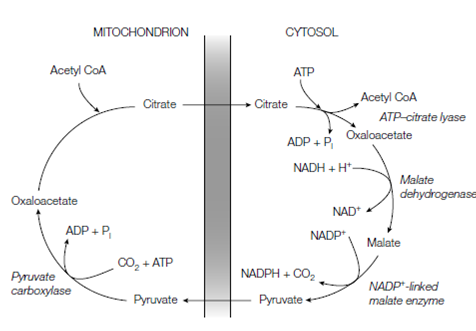Transport into the cytosol:
Fatty acids are synthesized in the cytosol, but acetyl CoA is generate from pyruvate in the mitochondria. Thus the acetyl CoA must be transferred from the mitochondria into the cytosol to permits fatty acid synthesis to occur. Moreover, the inner mitochondrial membrane is not readily permeable to this molecule. This problem is overcome through the condensation of acetyl CoA with oxaloacetate to form citrate. This is then transported into the cytosol where it is cleaved to regenerate acetyl CoA and oxaloacetate through ATP-citrate lyase in an energy-requiring procedure. The oxaloacetate, that also cannot cross the inner mitochondrial membrane, is back to the mitochondrial matrix through conversion first to malate (catalyzed by malate dehydrogenase) and then to pyruvate (catalyzed through NADP+ -linked malate enzyme) shown in the figure. This latter decarboxylation reaction generates NADPH that can be used in fatty acid synthesis. The remaining NADPH needed for fatty acid synthesis is provided through the pentose phosphate pathway. Once back in the

Figure: Transport of acetyl CoA from the mitochondrial matrix into the cytosol.
mitochondrial matrix, pyruvate is carboxylated to form oxaloacetate through pyruvate carboxylase with the hydrolysis of a although molecule of ATP shown in the figure.